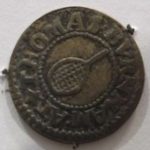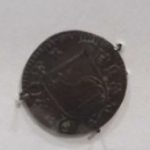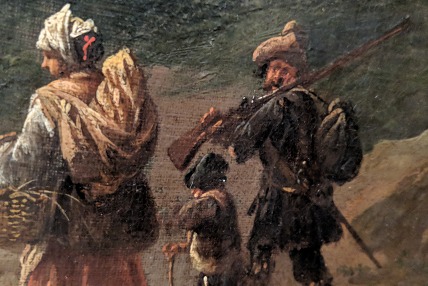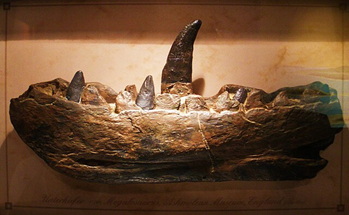How did Oxford continue to trade without coins?
Oxford had been an important centre of commerce since before the Norman period, because of its strategic position at a crossing point on the River Thames. The economy moved from trading and craftmanship to providing goods and services for the University, including food, drink, clothing and shoe making. Trade tokens were an alternative to coins minted by the crown and had no currency value. They were made of cheaper metals, such as copper or brass, and could be exchanged for goods.

Burnham’s trade token as a tennis court keeper
In 1642, Charles I moved his court from London to Oxford where the University supported the Royalist cause. A royal mint was established in New Inn Hall Street where St Peter’s Hall is today. Silver plate was melted down to produce coins quickly to pay his army. In 1649, he was captured, put on trial and beheaded. Under Cromwell as Lord Protector, there was no royal prerogative. The law no longer existed so token coinage was revived during the next twenty years. Following the English Civil War, trade in Oxford grew. The political unrest during this period resulted in small value coins being in very short supply so from 1652, farthing, halfpenny, and penny tokens were issued by towns and merchants whose businesses were struggling. Tradesmen would keep the tokens their customers had used to exchange for goods and later redeem their value from the issuer.
There were seventy known issuers all bearing the initials of the merchant and with his trade stamped on them. The reverse side showed his trade tools or produce. All common trades as mercer and chandler were represented. Three tennis court keepers, two ironmongers and glovers, and one each of an apothecary, fishmonger, coffee house keeper, rug maker, skinner, tobacconist, weaver, and saddler are listed. Some issuers were women: Ann Turton was an ironmonger and keeper of the Crown Tavern. Alce Lant, a cordwainer, issued a farthing token in 1667, with a shoe insignia. Their tokens, and others, can be seen in the Museum of Oxford (on loan from the Ashmolean Museum).

Ann Lant’s farthing for her services as a shoemaker
By far the largest number of tokens were issued by Oxford City. Twenty pounds bought two hundred weight of copper. Each token averaged seventeen grains (roughly 1.105 grams) so about 100,000 tokens in total would have been issued! Twelve variations, all dated ‘1652’ irrespective of the year they were struck, can be identified by the position of the lettering on the obverse side (principle side, usually features the face of a monarch/country). The letter ‘R’ on the reverse side with the date denotes that Thomas Rawlins, who had made coins and medals for the King, designed and engraved them. The tokens were struck in London so the charges included the design costs and carriage. Two leading citizens, George Potter and William Cave, were responsible for payment of the Oxford City tokens which complied with the design approved by the Council. There were three entries in 1652, totalling twenty one pounds, 6 shillings.

City of Oxford trade token
Parish records, town records, poll tax and hearth tax returns provide us with an insight into who the traders were and where they lived. Tokens issued by tavern and inn owners predominated in the City. Trade tokens were demonetized in 1672 when Charles ll introduced the first royal copper halfpenny and farthing issues. Those not redeemed from the issuers were melted down or discarded.
Written by MOX volunteer Joan Bellinger.
Want to write your own Oxford-inspired post? Sign up as a volunteer blogger.



